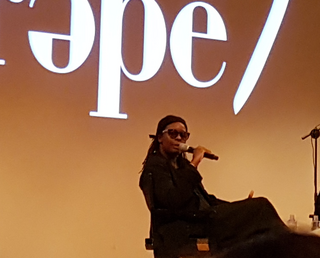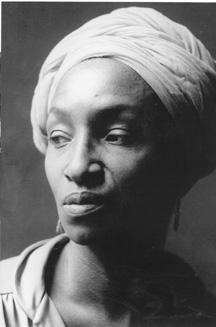Related Research Articles
Nobuyoshi Araki is a Japanese photographer and contemporary artist professionally known by the mononym Arākii (アラーキー). Known primarily for photography that blends eroticism and bondage in a fine art context, he has published over 500 books.

Yasumasa Morimura is a contemporary Japanese performance and appropriation artist whose work encompasses photography, film, and live performance. He is known for his reinterpretation of recognizable artworks and figures from art history, history, and mass media through his adoption of personas that transcend national, ethnic, gendered, and racial boundaries. Across his photographic and performative series, Morimura's works explore a number of interconnected themes, including: the nature of identity and its ability to undergo change, postcolonialism, authorship, and the Western view of Japan – and Asia, more broadly – as feminine.

Mariko Mori is a Japanese multidisciplinary artist. She is known for her photographs and videos of her hybridized future self, often presented in various guises and featuring traditional Japanese motifs. Her work often explores themes of technology, spirituality and transcendence.

Wangechi Mutu is a Kenyan-born American visual artist, known primarily for her painting, sculpture, film, and performance work. Born in Kenya, she has lived and established her career in New York City for more than twenty years. Mutu's work has directed the female body as subject through collage painting, immersive installation, and live and video performance while exploring questions of self-image, gender constructs, cultural trauma, and environmental destruction and notions of beauty and power.

Mickalene Thomas is a contemporary African-American visual artist best known as a painter of complex works using rhinestones, acrylic, and enamel. Thomas's collage work is inspired from popular art histories and movements, including Impressionism, Cubism, Dada, the Harlem Renaissance, and selected works by the Afro-British painter Chris Ofili. Her work draws from Western art history, pop art, and visual culture to examine ideas around femininity, beauty, race, sexuality, and gender.

Yoshiko Shimada is a Japanese printmaker and performance artist who has been referred to as "Japan’s premier feminist and antiwar artist."
Penny Slinger, sometimes Penelope Slinger, is a British-born American artist and author based in California. As an artist, she has worked in different mediums, including photography, film and sculpture. Her work has been described as being in the genres of surrealism and feminist surrealism. Her work explores the nature of the self, the feminine and the erotic.

Miriam Schapiro was a Canadian-born artist based in the United States. She was a painter, sculptor, printmaker, and a pioneer of feminist art. She was also considered a leader of the Pattern and Decoration art movement. Schapiro's artwork blurs the line between fine art and craft. She incorporated craft elements into her paintings due to their association with women and femininity. Schapiro's work touches on the issue of feminism and art: especially in the aspect of feminism in relation to abstract art. Schapiro honed in her domesticated craft work and was able to create work that stood amongst the rest of the high art. These works represent Schapiro's identity as an artist working in the center of contemporary abstraction and simultaneously as a feminist being challenged to represent women's "consciousness" through imagery. She often used icons that are associated with women, such as hearts, floral decorations, geometric patterns, and the color pink. In the 1970s she made the hand fan, a typically small woman's object, heroic by painting it six feet by twelve feet. "The fan-shaped canvas, a powerful icon, gave Schapiro the opportunity to experiment … Out of this emerged a surface of textured coloristic complexity and opulence that formed the basis of her new personal style. The kimono, fans, houses, and hearts were the form into which she repeatedly poured her feelings and desires, her anxieties, and hopes".
Laurie Simmons is an American artist, photographer and filmmaker. Since the mid-1970s, Simmons has staged scenes for her camera with dolls, ventriloquist dummies, objects on legs, and people, to create photographs that reference domestic scenes. She is part of The Pictures Generation, a name given to a group of artists who came to prominence in the 1970s. The Pictures Generation also includes Cindy Sherman, Barbara Kruger, and Louise Lawler.

Fatimah Tuggar is a interdisciplinary artist born in Nigeria and based in the United States. Tuggar uses collage and digital technology to create works that investigates dominant and linear narratives of gender, race, and technology. She is currently an Associate Professor of AI in the Arts: Art & Global Equity at the University of Florida in the United States.
Mary Beth Edelson was an American artist and pioneer of the feminist art movement, deemed one of the notable "first-generation feminist artists." Edelson was a printmaker, book artist, collage artist, painter, photographer, performance artist, and author. Her works have been shown at the Museum of Modern Art, the Smithsonian American Art Museum, and the Museum of Contemporary Art in Chicago.
Tomoko Sawada is a Japanese contemporary feminist photographer and performance artist. She has been included in numerous group shows in Japan, Europe and the US. Her first solo exhibition was in 1997 at Japan's Gallery Chat. In 2004 she was awarded the prestigious Kimura Ihei Memorial Photography Award for Young Japanese Photographer as well as the International Center of Photography Infinity Award in the category of Young Photographer.
Ingrid Mwangi is a German artist, of Kenyan-German descent. She works with photography, sculpture and in multimedia, performance, and installation art. In 2005, she co-founded Mwangi Hutter.
Mako Idemitsu is a pioneer Japanese media artist, known for her experimental video art and film works.

Kay Brown (1932-2012) was an African American artist, Printmaker, published author, Graphic and Fashion designer. She graduated at New York City College in 1968, with a Bachelor of Fine Arts degree. She was also a graduate at Howard University in 1986 with a Master of Fine Arts degree. Brown became the first woman awarded a membership into the Weusi Artist Collective, based in Harlem during the 1960s and 1970s. The Weusi Collective, named for the Swahili word for “blackness”, was founded in 1965, composed entirely of men. The fact that she was the only female member of this collective inspired her to seek out ways of representing the neglected Black female artists. She is widely acknowledged as one of the founders of the Where We At Black women artists' collective in New York City. Brown's works are credited for representing issues that affected the global Black community via her mixed media collages and prints. Brown's work was featured in the "We Wanted a Revolution" exhibition at the Brooklyn Museum.
Emily Allchurch is a British artist who is known for using digital photography and lightbox art to create new works based on masterpieces of world art.

Ming Smith is an American photographer. She was the first African-American female photographer whose work was acquired by the Museum of Modern Art in New York City.
Chikako Yamashiro is a Japanese filmmaker and video artist. Her works in photography, video and performance create visual investigations into the history, politics and culture of her homeland Okinawa. Particularly salient are themes related to the terrible civilian casualties incurred in Okinawa during World War II and the on-going troubles and hardships caused by the U.S. military presence in Okinawa. Since 2019 she is Associate Professor at the Tokyo University of the Arts.

Deborah Roberts is an American contemporary artist living and working in Austin, Texas. Consisting primarily of mixed media collage, Roberts’s work takes on the subject of otherness as understood against the backdrop of existing societal norms of race and beauty. Since graduating with an MFA from Syracuse University in 2014, she has exhibited widely. Her work has been shown at the Brooklyn Museum, Brooklyn, New York; SF MOMA, San Francisco, California; and the Whitney Museum of American Art, New York, New York.
Hiroko Okada also known as Okada Hiroko, is a Japanese contemporary artist, known for her provocative work that challenges societal standards around the construct of family, love, childbirth, and child-rearing. She works within the mediums of video art, photography, painting, installation, and performance.
References
- ↑ "Ryoko Suzuki: Anikora – Seifuku". Corkin Gallery. Retrieved 14 September 2015.
- ↑ "Ryoko Suzuki". washington.edu. Retrieved 14 September 2015.
- 1 2 Wakeling, Emily (1 December 2011). "'Ryoko Suzuki: "I am ..."'". The Japan Times.
- ↑ Yamaguchi, Yumi (2007). Warriors of Art: A Guide to Contemporary Japanese Artists (1st ed.). New York: Oxford Univ. Press / Kodansha International. p. 128. ISBN 978-4-7700-3031-3.
- ↑ Davis, Barry (15 August 2015). "Second-class citizens?". The Jerusalem Post. Retrieved 8 June 2023.
- ↑ Lev, Naomi (1 November 2018). "The Women Behind". The Brooklyn Rail. Retrieved 8 June 2023.